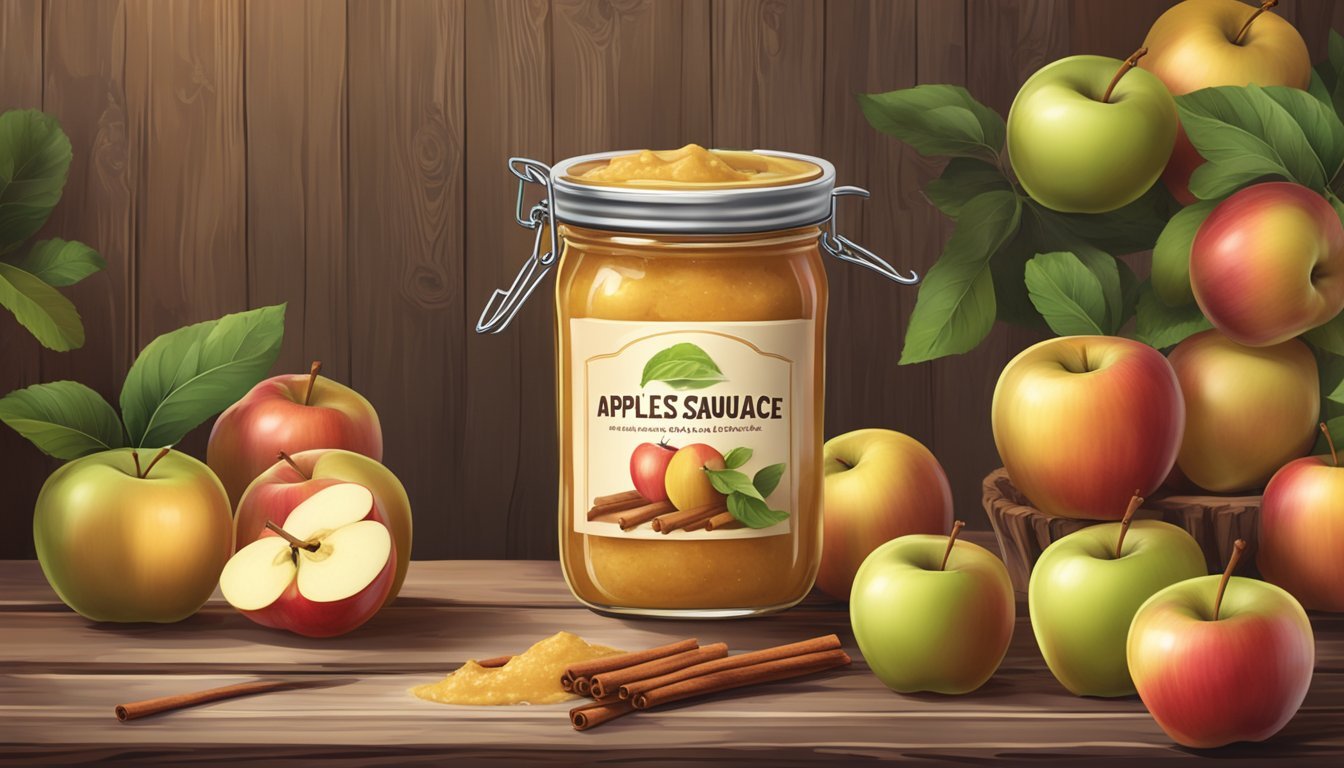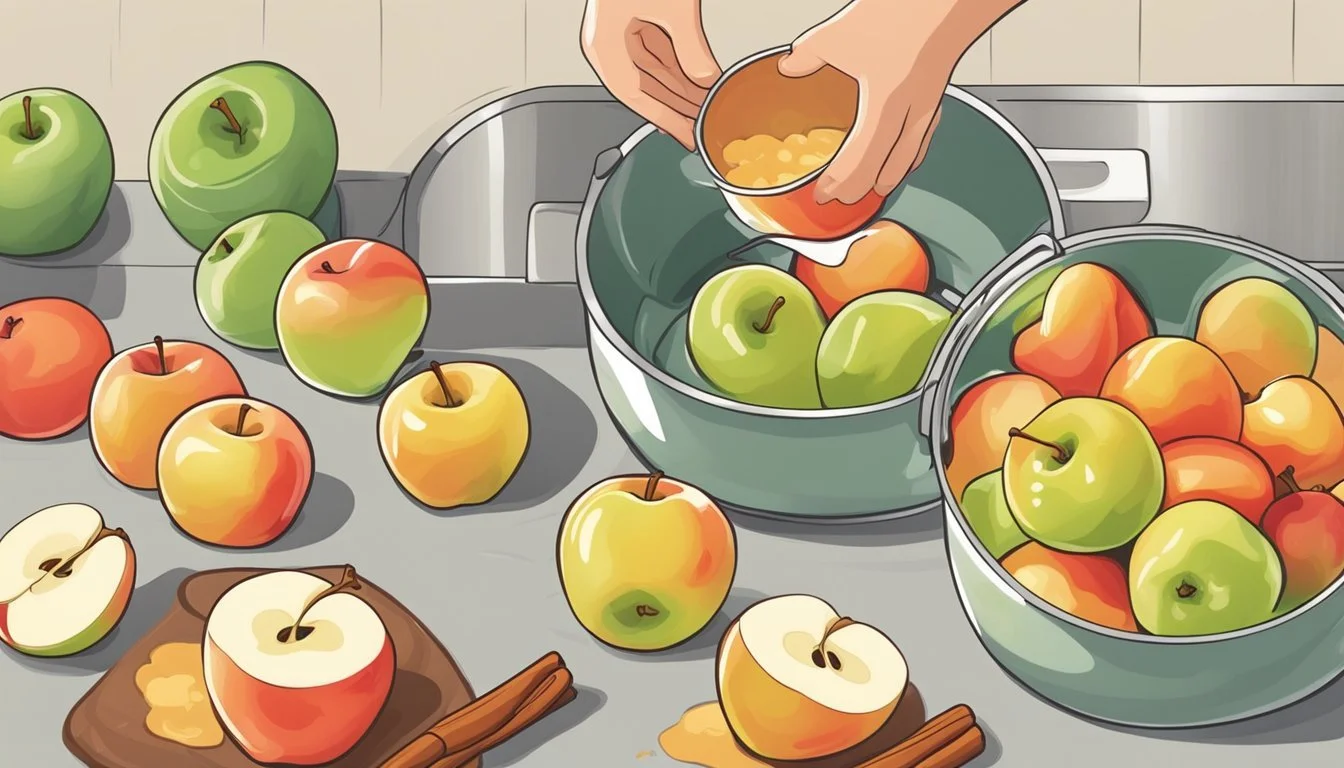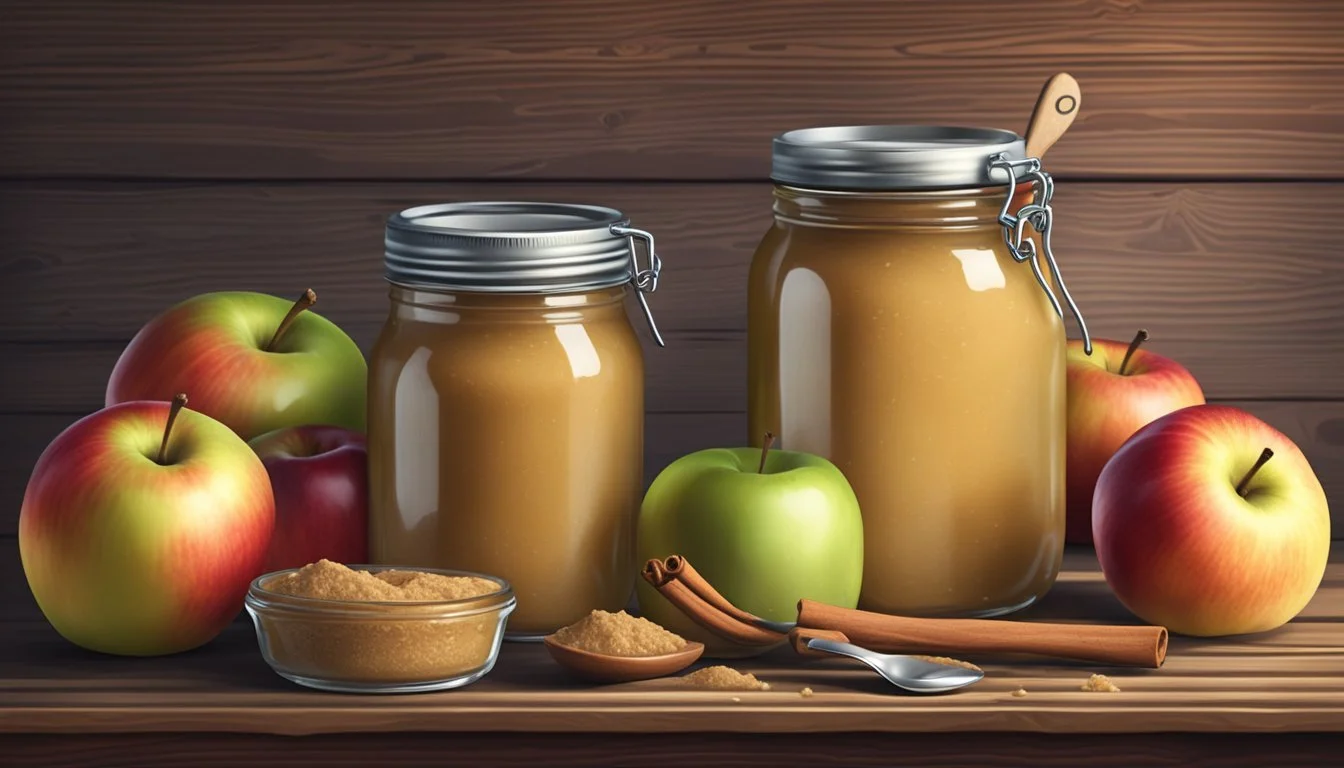Homemade Organic Applesauce Recipe
A Step-by-Step Guide for Healthy Snacking
Discover > Healthy Living Through Food > Homemade Organic Applesauce: A Step-by-Step Guide for Healthy Snacking
Homemade organic applesauce is a delicious and healthy snack that can be easily prepared in the comfort of your own kitchen. It's not only a healthier alternative to store-bought applesauce, but also an excellent way to make use of fresh, seasonal apples. There are various apple varieties suitable for making applesauce, and blending different types can result in unique flavors.
To make homemade organic applesauce, start by choosing the right combination of apple varieties. Use a mix of sweet and tart apples, such as organic Honeycrisp or Granny Smith, to create a balanced flavor. Make sure to wash the apples thoroughly and, if desired, peel them for a smoother texture. After coring and cutting the apples into chunks, combine them with a cup of water, lemon juice, and your choice of sweetener, such as maple syrup (how long does maple syrup last?) or brown sugar (how long does sugar last?), in a pot.
Cook the apple mixture over medium heat, ensuring that it doesn't scald, and continue to stir occasionally for 15 to 20 minutes. As the apples soften, you can use an immersion blender, food processor, or potato masher to achieve your preferred applesauce consistency - be it chunky or smooth. Once done, store the homemade applesauce in an airtight container for a convenient and healthy snack.
Selecting the Best Apples
When making homemade organic applesauce, choosing the right apples is essential for the perfect taste and consistency. This section will go over how to understand apple varieties and seasonal considerations to help you pick the best apples for your recipe.
Understanding Apple Varieties
There are many apple varieties, each with its own unique taste and texture. For applesauce, a mix of sweet and tart apples is ideal. Some popular apple varieties for applesauce include:
Organic Apples: Choosing organic apples guarantees they are free of pesticides, making your applesauce healthier.
Gala: A sweet apple with a mild flavor, perfect for a smoother texture.
Granny Smith: A tart apple that balances the sweetness in applesauce.
McIntosh: A mix of sweet and tart flavors, ideal for applesauce.
Honeycrisp: A sweet and juicy apple that makes a tasty applesauce.
Pink Lady: Another sweet and tangy, crisp apple option.
Consider combining different types of apples for a more complex flavor in your homemade applesauce recipe.
Seasonal Considerations
Apple season typically falls in the autumn months. Choosing in-season apples ensures optimum freshness, flavor, and nutritional value. Depending on your location, certain apple varieties may be in season and readily available. Be sure to check your local grocery store or farmer's market for the best selection.
When making your homemade organic applesauce, begin by cutting and coring the apples. Combine the apple chunks in a pot with a cup of water, lemon juice, and your choice of sweetener, such as maple syrup or brown sugar. Cook the mixture on medium heat until the apples reach the desired consistency. Use a food processor, immersion blender, or potato masher to blend the cooked apples to your preferred texture: smooth or chunky.
Remember to store your applesauce in an airtight container and serve it as a healthy snack or accompaniment to savory dishes. With the right selection of organic apples and proper preparation, you can enjoy a delicious and nutritious homemade applesauce.
The Applesauce Making Process
Preparation of Ingredients
When making homemade organic applesauce, it's essential to start with fresh, organic apples. Different apple varieties can produce varying flavors and textures in your applesauce, so choose a combination of sweet and tart apples for a balanced taste. Some popular choices include Golden Delicious, Granny Smith, and McIntosh.
Before getting started, gather the following ingredients:
6 cups of peeled, cored, and chopped organic apples
1 cup of water
Optional: natural sweeteners (e.g., maple syrup or brown sugar) and seasonings (e.g., cinnamon or lemon juice)
To ensure a smooth applesauce, it's best to peel the apples and remove the skins. However, if you prefer a chunkier applesauce with a more rustic texture, you can leave the skins on. To speed up the peeling and coring process, consider using an apple corer or a vegetable peeler.
Cooking Method
Add the chopped apples and 1 cup of water to a large pot. The water's purpose is to prevent the apples from sticking to the pot while they cook.
Place the pot over medium heat and bring the mixture to a low simmer. Make sure to stir occasionally with a wooden spoon to prevent scorching.
Cook the apples for about 20-25 minutes, or until they become soft and easy to mash.
To achieve your desired consistency, use one of the following tools:
Immersion blender for a smoother texture
Food processor for a slightly chunkier applesauce
Potato masher for a rustic, chunky applesauce
Once the apples are mashed, taste the applesauce and adjust the sweetness or seasoning as desired. If you prefer a sweeter applesauce, you can add maple syrup, brown sugar, or another natural sweetener to taste. Similarly, add a pinch of cinnamon or a splash of lemon juice for additional flavor.
Transfer the cooked applesauce to an airtight container, and store it in the refrigerator for up to a week. Homemade applesauce also freezes well, so you can make a large batch and save individual portions in freezer-safe containers for future use.
By following these simple steps, you can enjoy delicious and healthy homemade organic applesauce as a snack, dessert, or addition to savory dishes. The process is customizable to your preference, and you have the satisfaction of creating a homemade treat with minimal prep time and simple ingredients.
Flavoring and Sweetening
Organic homemade applesauce can be a healthy and delicious snack, customizable according to personal preferences. In this section, we discuss two methods of flavoring and sweetening the applesauce by "Using Natural Sweeteners" and "Adding Spices".
Using Natural Sweeteners
For those seeking a natural alternative to sugar, there are multiple options available. These include:
Honey: A popular natural sweetener that enhances the applesauce's flavor. Use in moderation, as it may alter the taste of the end product.
Maple Syrup: Another natural sweetener, maple syrup provides a unique, rich flavor to the applesauce. Use approximately 1/4 cup for every 4 cups of applesauce.
Organic Brown Sugar: Brown sugar can be used in place of white sugar, offering a more complex flavor profile to the final product.
Note that adding sweeteners is entirely optional, as some apple varieties are naturally sweet. It's recommended to taste the applesauce and adjust the sweetness to your preference.
Adding Spices
Incorporating spices into homemade applesauce is a simple way to elevate the flavor. Some popular options include:
Cinnamon: Organic ground cinnamon can be added to taste, typically around 1/2 to 1 teaspoon per 4 cups of applesauce.
Nutmeg: Nutmeg (how long does nutmeg last?) adds a warm, aromatic note to the applesauce. A pinch or two should suffice.
Lemon Juice: A little lemon juice (around 1 tablespoon) can brighten and enhance the overall flavor.
To make homemade organic applesauce, peel (if desired) and core organic apples, then cook them over medium heat with 1/4 cup of water until they become soft. Use an immersion blender, food processor, or potato masher to achieve the desired consistency. Optionally, add natural sweeteners and spices, then taste and adjust accordingly. Allow the applesauce to cool before transferring it to an airtight container.
Preservation and Storage
When it comes to enjoying homemade organic applesauce, knowing how to preserve and store it properly is essential. This helps maintain its flavor, freshness, and nutritional value. In this section, we will discuss useful refrigeration tips and methods for freezing and canning applesauce.
Refrigeration Tips
Storing homemade applesauce in the refrigerator is a great way to maintain its quality for a short period. Here's how to do it:
Allow the applesauce to cool down completely after preparing.
Use an airtight container to store the applesauce. This prevents air from entering and affecting the taste and consistency of the applesauce.
Store the container in the refrigerator. Homemade applesauce stays fresh in the refrigerator for up to 7-10 days.
Freezing and Canning
For longer-term storage, you can freeze or can homemade applesauce. Here are tips to help you preserve your applesauce using these methods:
Freezing:
Allow the applesauce to cool down completely after preparing.
Use airtight, freezer-safe containers with proper labeling for the content and date.
Leave about half-inch space at the top of the containers, as homemade applesauce tends to expand during freezing.
Frozen applesauce can last for up to a year in your freezer.
To consume frozen applesauce, defrost it naturally or quickly defrost by placing the container in warm water.
Canning:
Sterilize canning jars, lids, and rings by boiling them in water for 10 minutes.
While applesauce is still hot, carefully ladle it into the sterilized jars, leaving a half-inch headspace.
Wipe the jar's rim clean and place a sterilized lid and ring on top.
Process the jars in a boiling water bath for 20 minutes.
Remove the jars from the water and let them cool for 24 hours before checking the seals.
Canned applesauce can be stored in a cool, dark place for up to a year. Always ensure that the seal is intact before consuming.
Through proper preservation and storage, you can enjoy the wholesome taste of homemade organic applesauce all year round, making it both a healthy snack and a delightful ingredient in various culinary creations.
Creative Uses and Pairings
Desserts and Breakfasts
Homemade organic applesauce can be a versatile ingredient for both sweet and savory dishes. One popular way to utilize it is in desserts and breakfasts. For example, applesauce can be used as a topping for yogurt, ice cream, or waffles. It can also be used as a substitute for sugar or fat in recipes such as carrot cake. Here's a list of inspiring ideas:
Top yogurt or ice cream with warm applesauce and a sprinkle of cinnamon
Serve applesauce alongside waffles or pancakes with a drizzle of maple syrup
Replace oil or butter in a carrot cake recipe with applesauce for a healthier version
Homemade Baby Food
Making homemade applesauce for baby food is a simple and nutritious option for your little one. You can easily control the ingredients, consistency, and sweetness level to cater to your baby's preferences. To make baby-friendly applesauce, follow these steps:
Choose organic apples: Opt for sweet apples, such as Fuji or Gala, for a naturally sweeter taste. A mix of apple varieties can also create a balanced flavor profile.
Wash and core the apples: You may choose to peel the apples, but unpeeled apples provide extra nutrients and fiber. Cut the apples into chunks.
Cook the apples with water: In a large pot, combine apple chunks, a cup of water, and a splash of lemon juice (optional). Set the heat to medium and cook for about 20 minutes, or until the apples are soft.
Mash or blend: For chunky applesauce, use a potato masher. For a smoother texture, use an immersion blender or a food processor.
Taste and adjust: Add sweeteners like maple syrup or brown sugar if needed. Be cautious with extra sugar, as babies are typically sensitive to sweet flavors.
Store in airtight containers: Once cooled, store the applesauce in safe containers and refrigerate or freeze as needed.
Using this simple recipe, you can create a delicious and healthy snack for your baby while knowing exactly what ingredients are included in their meal. Plus, homemade applesauce can easily transition from a baby food option to a versatile ingredient for the whole family to enjoy in various dishes and pairings.
Health and Dietary Information
Nutritional Benefits
Homemade organic applesauce is rich in nutrients that are essential for a healthy diet. It is an excellent source of vitamins and minerals, such as vitamin C, potassium, and dietary fiber. The apples used in making the applesauce provide natural sugars that act as a natural sweetener, eliminating the need for added sugars. Cinnamon, which is commonly added to the recipe, offers its own health benefits: it is known for its antioxidant properties and its potential to help regulate blood sugar levels.
Diet Considerations
Homemade organic applesauce has its place in various diets, such as vegan and no sugar diets. Since the recipe uses organic apples and natural ingredients, it is suitable for those following a clean eating or organic lifestyle.
Vegan: Homemade applesauce recipe is naturally vegan, as it does not contain any animal-derived ingredients.
No Sugar Diet: Making your own applesauce provides the flexibility to adjust the sweetness level according to personal preference. You can eliminate added sweeteners like maple syrup or brown sugar, and rely on the natural sweetness of the apples.
Here is a brief table summarizing the dietary considerations for homemade organic applesauce:
Vegan:
Applicable? Yes
No Sugar Diet:
Applicable? Yes
Gluten-Free:
Applicable? Yes
Organic Lifestyle:
Applicable? Yes
When making homemade organic applesauce, choose organic apples and ensure that the other ingredients used (such as cinnamon, lemon juice, and sweeteners) are also organic. Opt for different types of apples to create a unique blend of flavors and experiment with varying combinations to find the perfect taste.
In summary, homemade organic applesauce is a nutritious and versatile snack that can be easily adjusted to fit various dietary preferences. It offers numerous health benefits and is a delicious addition to a balanced diet.







